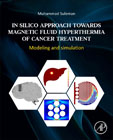
In Silico Approach Towards Magnetic Fluid Hyperthermia of Cancer Treatment: Modeling and Simulation
Suleman, Muhammad
Nanotechnology has the potential to present a more targeted approach to provide effective improvements for the treatment of cancer patients. Currently, radiotherapy, chemotherapy, surgery, and immunotherapy have been used as cancer treatment modalities, but these traditional treatment techniques are subjected to drawbacks of killing normal cells of the body, whereas magnetic fluid hyperthermia is the therapeutic modality that possesses the ability to overcome these drawbacks. In this therapeutic technique, magnetic nanoparticles are injected into the tumor and after their diffusion in the tumor, the external magnetic field is applied to heat the magnetic nanoparticles. In Silico Approach Towards Magnetic Fluid Hyperthermia in Cancer Treatment: Modeling and Simulation presents mathematical modeling and simulation approaches contrary to costly and time consuming in-vivo and in-vitro studies. Finite element method-based models of all hyperthermia processes of liver, brain, and breast tumors are simulated on COMSOL Multiphysics software. Problems of constant versus variable heat sources, the backflow problem, the enhanced permeation and retention effect, the flow around Happel's sphere in cells model structure, the deformation effect in poroelastic brain tumor, 3D flow through porous tissue, the reacting nanofluid flows, and optimization of parameters have been simulated for quantitative analysis. This important reference aids in hyperthermia treatment planning in clinical applications and provides an important compendium for practitioners as well as non-medical practicing scientists and engineers and is resource for both research and medical practice in hyperthermia treatment planning in clinical applications. Includes the diversities of cancer treatment modalities for their eradication with minimum damage to surrounding normal tissue Addresses tumors of different organs including liver, brain, and breast Deals with mathematical modeling and simulation approaches contrary to costly and time consuming in-vivo and in-vitro studies Provides insight on how to use hyperthermia in cancer treatment together with all other conventional types of treatments INDICE: 1. Introduction 2. Literature survey 3. Mechanism of heat generation by magnetic nanoparticles 4. Governing mathematical models 5 modeling the magnetic fluid hyperthermia of liver cancer 6 modeling the magnetic fluid hyperthermia of poroelastic brain tumor 7. Modeling the impact of nanoparticles size on tumor heating during thermal therapy of breast cancer 8. Magnetic fluid hyperthermia of female breast cancer in three dimensions 9. Enhanced permeation and retention effect (epr) 10. The mechanics of nanofluid flow around happel's sphere in the cell-model structure of the porous tumor 11. Three-dimensional transport of nanofluid in porous tumor 12. Simulation of the reacting nanofluid in the porous tumor 14. Steady-state and transient analysis of magnetic fluid hyperthermia of cylindrical tumor with optimization using nelder mead method 15. Optimization of velocity of nanofluid in micropore of porous tumor
- ISBN: 978-0-443-13286-5
- Editorial: Academic Press
- Encuadernacion: Rústica
- Fecha Publicación: 01/03/2023
- Nº Volúmenes: 1
- Idioma: Inglés
